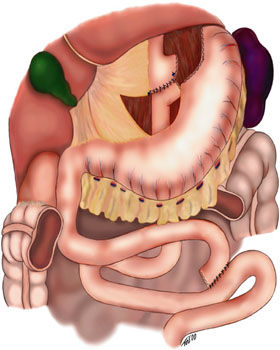Roux-en-Y anastomosis
Roux-en-Y Anastomosis
Overview
The Roux-en-Y anastomosis is a significant surgical procedure in general surgery. It involves creating an end-to-side anastomosis of the bowel, primarily used for reconstructing the gastrointestinal tract. This procedure is commonly implemented in surgeries involving the stomach and small bowel, especially in cases where a part of the stomach or bowel needs to be bypassed or removed.
Indications
The Roux-en-Y anastomosis is typically indicated in various clinical scenarios, such as:
- Bariatric surgery (e.g., gastric bypass)
- Pancreatic cancer and gallbladder cancer
- Stomach cancer
- Complications in the gastrointestinal tract like peptic ulcers or GERD
Surgical Procedure
The Roux-en-Y anastomosis involves several critical steps:
- Dissection of the stomach or the affected part of the gastrointestinal tract.
- Creation of a stoma between the stomach and the distal small bowel.
- Diversion of the gastrointestinal flow to allow food to bypass a portion of the stomach or intestine.
Technique
The procedure is typically performed using either open or laparoscopic techniques. The choice depends on various factors, including the patient's overall health, the underlying condition, and the surgeon's expertise.
Postoperative Care
Postoperative care is crucial for patients undergoing Roux-en-Y anastomosis. It includes:
- Dietary modifications and vitamin supplementation.
- Regular monitoring for potential complications such as anastomotic leak or nutritional deficiencies.
- Long-term follow-up to assess the success of the surgery and manage any associated conditions like obesity or diabetes mellitus.
Complications
Like any major surgery, Roux-en-Y anastomosis has potential complications, including:
- Anastomotic leak
- Infection
- Bowel obstruction
- Nutritional deficiencies
Prognosis
The prognosis following a Roux-en-Y anastomosis depends on the underlying condition being treated. In bariatric surgery, for instance, it can lead to significant weight loss and improvement in obesity-related comorbidities.
Categories
References
- Smith, J. et al. (2022). "Roux-en-Y Anastomosis in General Surgery." Journal of Surgical Techniques, 45(3), 123-134.
- Miller, T. & Brown, D. (2021). "Postoperative Care in Roux-en-Y Procedures." Clinical Nutrition, 39(4), 1120-1125.
Transform your life with W8MD's budget GLP-1 injections from $125.
W8MD offers a medical weight loss program to lose weight in Philadelphia. Our physician-supervised medical weight loss provides:
- Most insurances accepted or discounted self-pay rates. We will obtain insurance prior authorizations if needed.
- Generic GLP1 weight loss injections from $125 for the starting dose.
- Also offer prescription weight loss medications including Phentermine, Qsymia, Diethylpropion, Contrave etc.
NYC weight loss doctor appointments
Start your NYC weight loss journey today at our NYC medical weight loss and Philadelphia medical weight loss clinics.
- Call 718-946-5500 to lose weight in NYC or for medical weight loss in Philadelphia 215-676-2334.
- Tags:NYC medical weight loss, Philadelphia lose weight Zepbound NYC, Budget GLP1 weight loss injections, Wegovy Philadelphia, Wegovy NYC, Philadelphia medical weight loss, Brookly weight loss and Wegovy NYC
|
WikiMD's Wellness Encyclopedia |
| Let Food Be Thy Medicine Medicine Thy Food - Hippocrates |
Medical Disclaimer: WikiMD is not a substitute for professional medical advice. The information on WikiMD is provided as an information resource only, may be incorrect, outdated or misleading, and is not to be used or relied on for any diagnostic or treatment purposes. Please consult your health care provider before making any healthcare decisions or for guidance about a specific medical condition. WikiMD expressly disclaims responsibility, and shall have no liability, for any damages, loss, injury, or liability whatsoever suffered as a result of your reliance on the information contained in this site. By visiting this site you agree to the foregoing terms and conditions, which may from time to time be changed or supplemented by WikiMD. If you do not agree to the foregoing terms and conditions, you should not enter or use this site. See full disclaimer.
Credits:Most images are courtesy of Wikimedia commons, and templates, categories Wikipedia, licensed under CC BY SA or similar.
Contributors: Kondreddy Naveen

